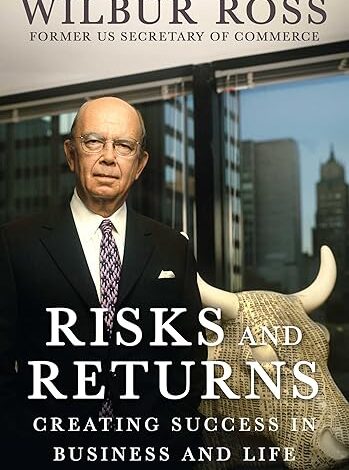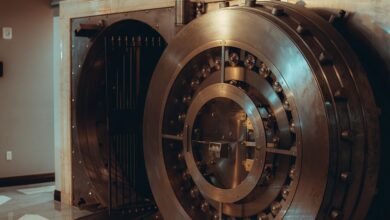Book Review: Risks and Returns

Risks and Returns: Creating Success in Business and Life. 2024. Wilbur Ross. Skyhorse Publishing.
President of Faulkner, Dawkins & Sullivan Securities Corporation at age 29. Head of investment banking at Rothschild, Inc. Founder of a private equity firm. Board president of The Dakota cooperative apartment building when resident John Lennon was shot to death there. Vice chairman of the Brooklyn Museum. Chairman of the Smithsonian Institution’s National Board. President of the Japan Society. Trustee of Sarah Lawrence College. US Secretary of Commerce.
Wilbur Ross has excelled in a wide variety of leadership roles. His memoir Risks and Returns emphasizes both the qualities that contributed to his success and the lessons he has drawn from his experiences. This highly readable book also contains numerous entertaining anecdotes about, and descriptions of, the lifestyles of the rich and famous. Its educational value to CFA charterholders primarily involves the following topics.
Bankruptcy Process
Ross earned the soubriquet “King of Bankruptcy” as an investment banker advising parties in negotiations to settle claims of companies that defaulted on their debts — as well as a principal who acquired and revived several such companies. Understanding bankruptcy resolution and turnrounds is essential for investors in lower-rated and distressed bonds, and most commentary on the subject is written by lawyers and securities analysts. That literature is quite informative, but Ross is able to provide a fresh and valuable perspective by drawing on his involvement in such prominent bankruptcies as Drexel Burnham Lambert, Federated Department Stores, Pan Am, Texaco, Trump Taj Mahal, and Trans World Airlines (TWA).
Especially noteworthy is how Ross highlights the importance of labor relations in resurrecting failed businesses. He notes that the unprofitable steel subsidiaries of Ling-Temco-Vought (LTV), which WL Ross & Co. acquired, were hampered by the existence of 32 separate job classifications. The rolling mill operators and the maintenance workers were able to perform each other’s jobs. When the mill was running, however, the maintenance team sat around playing pinochle, and when the mill broke down, the operators were idled. Ross induced the plants’ union to reduce the job classifications to five, which greatly increased efficiency.

Trade Policy
Issues of international trade have important investment implications both at the macroeconomic level and for corporations that export goods, source parts offshore, or compete with imported products. Many readers undoubtedly share this reviewer’s free trade orientation, and they will find their certitude challenged by Ross’s defense of protectionist measures to counter trade barriers erected by other countries. He notes that ardent free trader Lawrence Kudlow supported the Trump administration’s tough stance against China, saying that country’s behavior regarding trade puts it in a category by itself.
Cryptocurrency
Ross’s skepticism about Bitcoin and its brethren extends beyond the most common criticisms. “Having seen hackers penetrate our most secret federal agencies,” he writes, “the notion that only the pseudonymous founder of cryptocurrency, Satoshi Nakamoto, could figure out the algorithm that creates seem[s] highly improbable” (p. 336). He also declares unproven the assumption that sufficient demand exists for the supply of Bitcoin that can ultimately be created.
It does not detract from the overall excellence of Risks and Returns to surmise that some investment professionals who read it will remain unpersuaded by Ross’s arguments on certain controversial topics. So much the better if his willingness to wade into such issues sparks lively debate. Here is just one example of the potential for productive dialogue that the book creates:
Outside the financial sphere, Ross hails former New York mayor Rudolph Giuliani’s success in “drastically reducing crime.” On the contrary, argues the Poynter Institute — a journalism school and research organization judged by public benefit corporation AllSides Technologies to show no political bias toward either the left or the right — independent studies generally have found no link between the Giuliani administration’s tactics and the drop in the crime rate. Violent crime had already been declining in New York for three years before Giuliani took office in 1994, according to US Justice Department records. Moreover, crime fell sharply throughout the country in the 1990s, with San Francisco leading other major cities. Many criminologists attribute the nationwide drop in crime to a complex combination of causes, including a waning of the crack cocaine epidemic.
In addition to thought-provoking commentary on a wide variety of topics, Risks and Returns provides fascinating glimpses of financial history. Readers learn about the end of fixed commissions on the New York Stock Exchange and the birth of the loan-to-own strategy. Ross also recounts his early career as an innovative airline analyst. He distinguished his team’s efforts from the competition by using weekly takeoff and landing data to forecast carriers’ monthly earnings, which the Civil Aeronautics Board required them to report. Ross describes his encounters with financial luminaries such as Carl Icahn, Victor Posner, and Paul Singer, as well as confrontations with American communists and Neapolitan organized crime lords. Readers’ interest will never flag as they glean the chunks of wisdom that they can productively apply to investment analysis.





